Published on Nov 20, 2025
Daily Current Affairs
Current Affairs 20 November 2025

Content
- SC Strikes Down Provisions of Tribunal Reforms Act; Orders Creation of National Tribunal Commission
- Red Fort Blast Exposes Rising Threat of Digital Tradecraft in Terrorism
- ISRO Successfully Tests Bootstrap Start of CE20 Cryogenic Engine
- IRDAI Completes Pilot of Bima Gram API to Boost Rural Insurance Mapping
- Climate Attribution Science Gains Importance Amid Pollution, Acid Rain, GLOFs, Cyclone Events
- Tihar Jail Introduces Cow Therapy to Improve Inmate Mental Health and Rehabilitation
- Lancet Flags Sharp Surge in Ultra-Processed Foods and India’s Escalating NCD Burden
- Tiger Returns to Gujarat After Decades of Local Extinction; Confirmed in Ratanmahal Sanctuary
SC strikes down provisions of Tribunal Reforms Act, tells govt. to set up panel
Why is it in News?
- Supreme Court struck down key provisions of the Tribunal Reforms Act 2021.
- The law centralized control of tribunals under the Union government, affecting appointments, salaries, and functioning.
- Court emphasized that such control undermines independence, impartiality, and effective adjudication.
- Direction issued to establish a National Tribunal Commission within four months to safeguard tribunal autonomy.
Relevance:
- GS 2: Polity & Governance — tribunal independence, separation of powers, judicial review, constitutional safeguards.
- GS 2: Parliament–Judiciary Relations — limits of legislative override, institutional autonomy, rule of law.
- GS 2: Administrative Reforms — need for National Tribunal Commission, uniform standards across tribunals.
- GS 2: Rights Issues — impact on access to justice under Article 14 and 21.
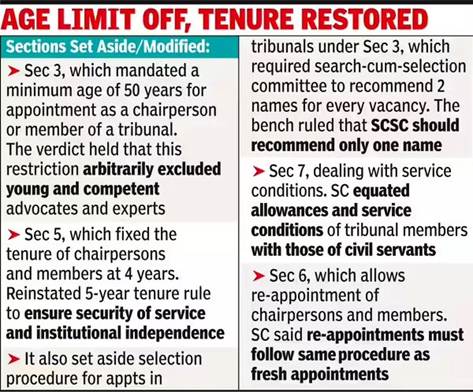
Background:
- Tribunals in India: Specialized quasi-judicial bodies to adjudicate disputes in administrative, fiscal, and regulatory domains (e.g., NCLT, ITAT, CAT).
- Purpose of Tribunal Reforms Act 2021:
- Rationalize tribunals, unify functioning, streamline appointments.
- Enable government to set salaries and conditions of service.
- Prior Legal Context:
- Tribunal Reforms Ordinance 2021 was struck down by SC in July 2021.
- The 2021 Act was essentially a “repackaged version” of the Ordinance.
Key Issues Identified by the SC:
- Independence and impartiality: Executive control over appointments and tenure undermines constitutional principles.
- Tenure: Arbitrary curtailment violates security of office and institutional autonomy.
- Functioning & salaries: Government control over operational aspects breaches the spirit of separation of powers.
- Repetition of invalid law: 2021 Act mirrors Ordinance struck down earlier, showing legislative overreach.
Supreme Court Observations:
- Parliamentary reforms must align with constitutional requirements, not just administrative convenience.
- Tribunal independence is an essential structural safeguard for fair adjudication.
- Establishing a National Tribunal Commission will:
- Ensure transparency in appointments.
- Maintain uniformity across tribunals.
- Protect institutional autonomy.
Implications:
- Judicial independence: Strengthens the judiciary’s oversight on executive interference in quasi-judicial bodies.
- Tribunal governance: Moves toward a transparent, uniform, and accountable tribunal system.
- Legislative caution: Parliament cannot bypass constitutional safeguards under the guise of administrative reforms.
The threat of digital tradecraft in terrorism
Why is it in News?
- On November 10, 2025, a car explosion near Delhi’s Red Fort Metro Station killed at least 15 people and injured over 30.
- National Investigation Agency (NIA) investigating the incident under counter-terrorism laws.
- The probe highlights the use of advanced digital tradecraft by modern terror modules, signaling an evolution in terrorist operational methods.
Relevance:
- GS 3: Internal Security — terrorism trends, encrypted communication, digital tradecraft, operational security.
- GS 3: Cyber Security — encryption regulation, metadata gaps, self-hosted servers, digital forensics challenges.
- GS 3: Role of Technology in Terrorism — VPN use, closed communication loops, dead-drop emails.
- GS 2: Governance & Policy — legal gaps in counter-terror legislation, need for tech-diplomacy, institutional preparedness.
Background:
- Location: Gate No. 1, Red Fort Metro Station, Delhi.
- Casualties: 15+ dead, 30+ injured.
- Initial classification: Terrorist attack, not an accident.
- Key suspects: Three doctors linked to Al Falah University, Faridabad – Dr. Umar Un Nabi, Dr. Muzammil Ganaie, Dr. Shaheen Shahid.
- Possible ideological linkage: Investigation ongoing into connections with Jaish-e-Mohammed (JeM) or JeM-inspired module.
Major Findings from the Investigation:
- Encrypted communication:
- Suspects allegedly used Threema, a Swiss messaging app with no personal identifiers, end-to-end encryption, and minimal metadata retention.
- Potential self-hosted Threema server to create a closed network for sharing maps, documents, and instructions.
- Dead-drop emails:
- Shared email accounts used to save unsent drafts; other members accessed and updated drafts, leaving no digital footprint.
- Classic spycraft adapted for the digital age.
- Reconnaissance & logistics:
- Multiple recce missions in Delhi.
- Stockpiling of ammonium nitrate explosives, possibly using familiar vehicles to avoid suspicion.
- Operational discipline:
- Suspects reportedly cut digital links and switched off phones after arrests, indicating high operational security awareness.
- Digital sophistication:
- Blend of encrypted apps, private servers, VPNs, and minimal online footprint demonstrates multi-domain tradecraft.
Academic & Strategic Overview:
- Aligns with counter-terrorism research: terrorists increasingly use E2EE tools, decentralized networks, and spy-style communication.
- Traditional surveillance (phone tapping, metadata collection, email intercepts) is less effective against encrypted, privacy-preserving technologies.
- Self-hosted infrastructure and VPN/proxy use highlights cross-border digital mobility of terror modules.
Policy & Strategic Implications:
- Digital forensics enhancement:
- Establish specialized teams skilled in encrypted-platform analysis, server forensics, and memory dumping.
- Regulation of private/self-hosted servers:
- Mandate compliance with lawful access obligations while balancing privacy rights.
- Legal framework updates:
- Explicitly address encrypted/decentralized communication in counter-terrorism laws.
- Train investigators in detecting digital dead-drop mechanisms and shared draft mailboxes.
- Community & institutional engagement:
- Early detection of radicalization in professional and academic spaces.
- Tailored counter-radicalization programs for highly educated recruits.
- International cooperation:
- Strengthen intelligence-sharing and tech diplomacy.
- Collaborate with foreign governments and tech companies hosting encrypted platforms.
- Public awareness:
- Inform society about evolving terror tradecraft in digital spaces.
Key Takeaways:
- Modern terror modules integrate digital tradecraft, operational discipline, and ideological motivation.
- Threats now span physical and digital domains, requiring multidisciplinary counter-terrorism approaches.
- India (and democracies globally) must adapt to counter encrypted, decentralized, and private communication networks alongside conventional security measures.
CE20 cryogenic engine
Why in News?
- ISRO successfully demonstrated the bootstrap mode start test of the CE20 cryogenic engine on November 7, 2025.
- This marks a major step toward enabling in-flight multiple restarts of the LVM3 (GSLV Mk-III) upper stage engine.
- Enhances mission flexibility, allowing future multi-orbit and Gaganyaan missions to optimize payload deployment and orbital insertion.
Relevance:
- GS 3: Science & Technology — cryogenic propulsion, multi-restart engines, indigenous capability.
- GS 3: Space Technology — applications to Gaganyaan, multi-orbit deployment, heavy-lift missions.
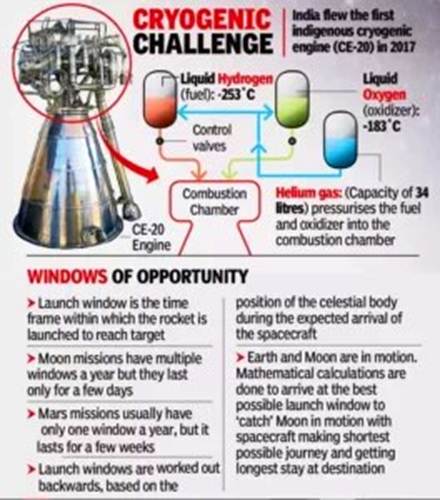
Background:
- ISRO: Indian Space Research Organisation, responsible for India’s space programs and launch vehicles.
- LVM3 (Launch Vehicle Mark-3): Heavy-lift launch vehicle, capable of deploying satellites to GTO/LEO and supporting human spaceflight (Gaganyaan).
- CE20 Cryogenic Engine:
- Powers the upper stage of LVM3.
- Uses liquid hydrogen (fuel) and liquid oxygen (oxidizer).
- Previously qualified for single start operation at thrust 19–22 tonnes.
- Current Start System: Engine ignition uses tank head conditions, with turbo pumps started via stored gas start-up system. Each restart requires additional gas bottles, limiting operational flexibility.
Significance of Bootstrap Mode Start:
- Definition: Engine achieves steady operation without external start-up assistance.
- Advantages:
- Eliminates dependency on additional start-up gas bottles for multiple restarts.
- Enables multi-orbit missions or complex satellite deployments.
- Reduces weight and system complexity on the rocket.
- Enhances reliability and mission safety.
- Test Details:
- Conducted in High-Altitude Test (HAT) facility, ISRO Propulsion Complex, Mahendragiri.
- Duration: 10 seconds under vacuum conditions.
- Demonstrated ability to reach steady operation from bootstrap mode.
Implications for ISRO Programs:
- Gaganyaan Mission: Improves engine restart capability for manned missions requiring orbital maneuvering.
- Future LVM3 Flights: Allows flexible payload deployment across multiple orbits.
- Cryogenic Engine Technology: Demonstrates ISRO’s advanced propulsion capabilities and indigenous mastery of restartable cryogenic engines.
- Strategic Significance: Positions India for advanced satellite launches, space exploration missions, and multi-orbit applications.
Bima Gram API
Why is it in News?
- IRDAI’s Bima Gram API successfully completed its pilot testing phase, marking a key step toward improving insurance penetration in rural India.
- Initiative integrates digital tools to streamline, authenticate, and map insurance coverage at the village level, enhancing governance and financial inclusion.
Relevance:
- GS 3: Economy (Financial Inclusion) — rural insurance penetration, digital financial services.
- GS 2: Governance — regulatory reforms, data-driven policy design, village-level service delivery.
- GS 3: Inclusive Growth — protection against rural vulnerabilities, social security deepening.
Background:
- IRDAI: Insurance Regulatory and Development Authority of India, regulator of insurance industry.
- Bima Gram API: Digital interface enabling real-time validation and mapping of insurance policies in rural areas.
- Pilot Testing:
- Conducted with five insurers – 2 life, 2 general, 1 health insurer.
- Tested functionality, integration, and accuracy.
- Objective: Facilitate digital verification of insurance policies linked to gram panchayats, reducing reliance on manual documentation.
Significance of the Initiative:
- Efficiency & Accuracy:
- Speeds up insurance business reporting.
- Minimizes errors in rural insurance data.
- Data Mapping:
- Policies accurately mapped to villages, enabling granular monitoring.
- Policy Planning:
- Generates baseline datasets for insurers to plan future products and allocate resources effectively.
- Digital Inclusion:
- Empowers rural populations to access insurance services more transparently.
- Supports financial literacy and awareness initiatives.
Implications:
- For Rural Insurance Penetration:
- Streamlined coverage verification increases trust in insurers.
- Promotes inclusive growth and social security in rural India.
- For Insurers:
- Enhanced risk assessment and product targeting.
- Better compliance and reporting to regulators.
- For Governance:
- Supports government programs by providing reliable insurance data at village level.
- Enables monitoring of insurance outreach and coverage gaps.
Attribution science: the tricky task of linking disasters to emitters
Why in News?
- Delhi recorded severe air pollution with AQI over 400 on November 12, 2025, prompting public protests.
- Recent environmental studies and disasters, including acid rain trends, glacial lake floods in Uttarkashi, and Cyclone Montha impacts, highlight the growing threat of climate-induced extremes.
- Climate attribution science is increasingly used to link local events to global warming, raising both scientific and policy implications.
Relevance:
- GS 3: Environment & Ecology — climate change attribution, extreme events, disaster-linked pollution.
- GS 3: Disaster Management — GLOFs, cyclone intensification, early warning systems.
- GS 3: Pollution Control — acid rain trends, urban AQI crisis, point vs non-point source emissions.
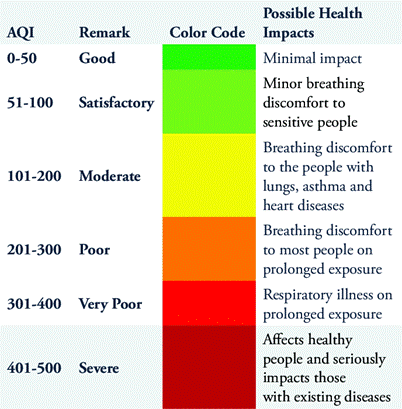
Background:
- Air Pollution in Delhi:
- Contributing factors: vehicle emissions, crop residue burning in neighbouring states, Diwali firecrackers, seasonal wind patterns.
- Health impacts: respiratory ailments, cardiovascular stress, public protests highlighting citizen concern.
- Acid Rain:
- Studies (IMD & IITM, Pune) show increasing acidity in rainwater over three decades.
- Local examples: Visakhapatnam (fossil fuel and port emissions), Dhanbad (coal mining emissions, chemical reactions forming secondary pollutants).
- Glacial Lake Outburst Floods (GLOFs):
- Uttarkashi flash floods (2025) reminiscent of 2013 Kedarnath disaster.
- Cause: glacier melt, climate change influencing intensity of rainfall and snow melt.
- Cyclone Intensification:
- Cyclone Montha (October 2025) impacted Andhra Pradesh, with warming seas increasing moisture and storm intensity.
Climate Attribution Science:
- Purpose: Estimates how human-induced climate change alters frequency, intensity, and probability of extreme events.
- Methodology:
- Models simulate the world without anthropogenic greenhouse gases and compare to observed events.
- Attribution more accurate for heat waves than extreme rainfall or floods.
- Uses satellite observations, chemical transport modelling, and historical trends.
- Examples:
- Kedarnath floods: increased June rainfall linked to rising greenhouse gases and aerosols.
- Acid rain: linked to specific point sources (power plants, industrial clusters).
Key Observations:
- Point vs Non-Point Sources:
- Point sources: concentrated emissions (e.g., power plants).
- Non-point sources: dispersed emissions (vehicles, agriculture).
- Global vs Local Responsibility:
- India’s cumulative CO2 since 1850 <6%.
- Developed nations bear larger historical responsibility for climate change.
- Legal and Economic Implications:
- Advances in climate economics and attribution raise the possibility of climate litigation against major fossil fuel companies.
- Potential for monetary/injunctive relief for climate-induced damages.
Policy and Strategic Implications:
- Urban Air Quality Management:
- Strengthen monitoring, regulate vehicular emissions, manage seasonal crop burning.
- Disaster Preparedness:
- Early warning systems for GLOFs and cyclones.
- Community awareness and climate-resilient infrastructure.
- Energy Transition:
- Continue expansion of solar, wind, and battery storage to reduce future emissions.
- Climate Justice:
- Developed countries may need to compensate developing nations for historical emissions.
- Research & Modelling:
- Improve climate models for better event attribution, particularly for rainfall and flood events.
Tihar Jail cow therapy initiative
Why is it in News?
- Tihar Jail, Delhi launched a new gaushala initiative on November 19, 2025, to use cow therapy for improving mental health among inmates.
- Initiative is inspired by earlier pilots in Haryana and Sweden and aims to promote mental well-being, compassion, and rehabilitation.
Relevance:
- GS 2: Social Justice — prisoner rehabilitation, mental health interventions, behavioural reform.
- GS 2: Governance — prison management reforms, NGO collaboration, digital transparency.
- GS 1: Society — compassion-based therapy, reintegration strategies, humanisation of incarceration.
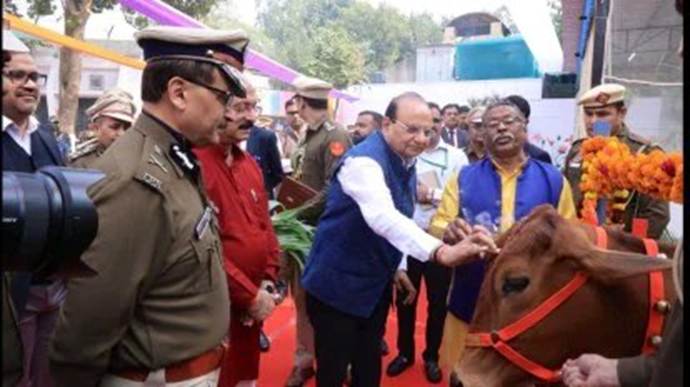
Background:
- Gaushala Concept: Shelter for indigenous cows, particularly Sahiwal breed.
- Cow Therapy: Psychological intervention using interaction with cows to reduce loneliness, promote emotional well-being, and spread kindness.
- Initiative Scope:
- Started with 10 cows, planned to scale over time.
- Aims to integrate therapy with vocational training, including milk production and puja material preparation.
- Previous Models:
- Haryana and Sweden: Similar cow therapy projects showed positive results for mental health and rehabilitation.
Implementation in Tihar Jail:
- Small-scale pilot in jails 2 and 3, integrating inmates in animal care.
- Prison officials see gaushala as a centre of learning, compassion, and transparency.
- No direct visits or calls; inmates benefit through daily care and interaction.
- Initiative also part of rehabilitation and skill-building programs for inmates.
Additional Support Systems:
- Digital Integration:
- Products from Tihar’s cow shed to be sold via Tihar’s online store (My Store).
- Real-time tracking of essential items and NGO collaboration for rehabilitation support.
- Inventory Management System: Monitors supply of food, medicines, and essential items.
- NGO Collaboration: Registration portal for NGOs to strengthen inmate rehabilitation programs.
Impact:
- Mental Health: Reduces loneliness, promotes emotional resilience.
- Skill Development: Enables inmates to earn a livelihood and support their families post-release.
- Social Rehabilitation: Encourages responsibility, empathy, and humane treatment of animals.
- Institutional Transparency: Digital tracking and NGO oversight ensures accountability.
Experts red-flag ultra-processed food retail surge
Why in News?
- Recent Lancet series (three-paper global study) highlights the sharp rise in ultra-processed food consumption in India and its health consequences.
- Retail sales of ultra-processed foods rose from $0.9B in 2006 → ~$38B in 2019 (≈40-fold increase).
- Obesity, diabetes, and other non-communicable diseases (NCDs) are surging concurrently.
- Signals urgent need for policy action on diet, marketing, and public health.
Relevance:
- GS 2: Health — obesity, diabetes, NCD burden, dietary transition, public health policy.
- GS 3: Economy — rising healthcare expenditure, productivity loss due to lifestyle diseases.
- GS 3: Science & Tech / Food Systems — food processing industry, aggressive marketing, supply-chain expansion.
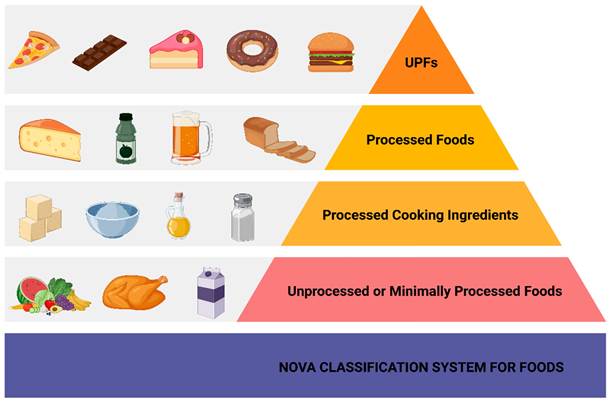
Definition
- Ultra-Processed Foods (UPFs): Foods industrially formulated from refined ingredients, preservatives, additives; high in calories, low in nutrients; examples: soft drinks, chips, chocolates, instant noodles.
- Characteristics: Convenient, long shelf-life, hyper-palatable, aggressively marketed.
- Health Concern: Associated with obesity, Type 2 diabetes, hypertension, heart, kidney, GI disorders, depressive symptoms.
Current Scenario in India
- Obesity: 28.6% adults affected (≈1 in 4).
- Diabetes: 11.4% adults (≈1 in 10).
- Prediabetes: 15.3% adults.
- Abdominal obesity: 39.5% adults.
- Childhood obesity: Increased from 2.1% (2016) → 3.4% (2019–21).
- UPF market growth: $0.9B → $38B between 2006–2019; rapid penetration into Indian diets.
Why UPFs are Harmful ?
- High-calorie, low-nutrient → excess energy intake.
- Frequent consumption adds ≥500 extra calories/day → fat deposition, particularly visceral fat.
- Visceral obesity increases metabolic risks: Type 2 diabetes, cardiovascular diseases, hypertension.
- Aggressive marketing normalizes unhealthy diets, replacing traditional meals.
Policy and Regulatory Gaps
- India lacks precise data on UPF consumption patterns.
- Current regulations insufficient to curb marketing, especially targeting children.
- No uniform policy to manage food environment or labeling standards effectively.
Global & Scientific Context
- Lancet series authored by 43 global experts: warns of worldwide trend of UPF consumption replacing traditional diets.
- Echoes global concerns: NCD burden rising in low- and middle-income countries due to dietary transition.
- Nutrition experts stress urgent intervention to prevent “nutrition transition” from traditional healthy diets to industrialized diets.
Implications for India
- Rising healthcare burden from obesity and NCDs.
- Early onset of metabolic diseases in children.
- Genetic predisposition of Indians to visceral obesity intensifies risk.
- Need for multi-pronged interventions: public awareness, marketing restrictions, fiscal policies (taxation/subsidies), school nutrition programs.
Declared extinct decades ago, a tiger returns to ‘new home’ — in Gujarat forest
Why is this in News?
- Gujarat has recorded the return of a tiger after decades of local extinction, with confirmed sightings in Ratanmahal Wildlife Sanctuary .
- Tiger was repeatedly captured on camera traps since Feb 2025, establishing territorial presence.
- Marks Gujarat’s entry into states hosting three big cats (lion–tiger–leopard), and preparing for the fourth (cheetah) under Project Cheetah in Banni Grasslands.
Relevance:
- GS 3: Environment & Ecology — wildlife conservation, carnivore dispersal, habitat connectivity.
- GS 3: Biodiversity — species recovery, local extinction reversal, multi-big-cat landscape.
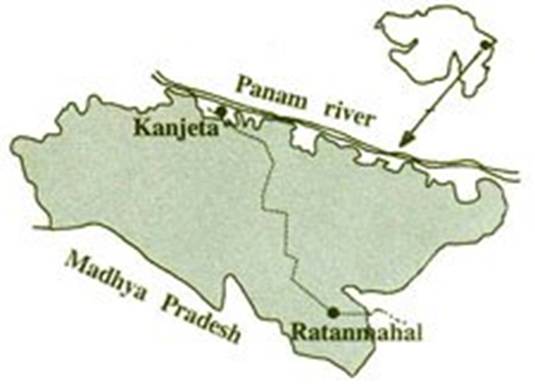
Basics
- Local Extinction: When a species disappears from a specific region but exists elsewhere. Tigers were declared locally extinct in Gujarat decades ago.
- Source Landscape: Tiger likely dispersed naturally from Madhya Pradesh’s Kathiawar/Chhota Udepur landscape, which has a healthy population.
- Ratanmahal Wildlife Sanctuary:
- Location at the MP–Gujarat border
- Rich prey base (nilgai, wild boar, monkeys; sambar/spotted deer in monsoon)
- Dense habitat suitable for large carnivores
What Has Happened?
- First detection:
- Large pugmarks noticed on 23 Feb 2025 during patrol.
- Camera trap photo timestamped 22 Feb, 2:40 AM confirmed tiger presence.
- Regular sightings: Recurrent captures through multiple months prove it has established territory.
- Forest department action:
- Increased number of camera traps
- Ensured water availability
- Prey augmentation measures
- Fire prevention and habitat protection
- Constant monitoring of tiger health and movements
- NTCA informed: Formal recognition of tiger presence in Gujarat.
Significance
- Ecological Milestone:
- Restoration of natural carnivore range → improved ecosystem health.
- Indicates successful habitat integrity on Gujarat–MP border.
- Conservation Success Indicator:
- Shows connectivity corridors between MP and Gujarat are functional.
- Natural dispersal is a strong marker of forest ecosystem recovery.
- Big Cat Diversity:
- Gujarat already has Asiatic lions (Gir) and leopards widely spread.
- Now adds tiger presence, becoming a multi–big-cat state.
- Work underway to add cheetahs via reintroduction (Banni Grasslands).
Project Cheetah Link
- Gujarat preparing a 600-hectare cheetah breeding and conservation centre in Banni Grasslands, Kutch.
- Jointly funded by Centre + State.
- Will make Gujarat home to all four big cats — lion, tiger, leopard, cheetah.
Why Tigers Disappeared from Gujarat?
- Habitat loss due to agriculture expansion and fragmentation
- Prey depletion
- Poaching and human pressure
- Lack of tiger-specific conservation efforts (state focus on lions)
Current Conservation Implications
- Need for landscape-level management for long-term tiger survival.
- Potential requirement for corridor protection between MP and Gujarat forests.
- Possible future creation of a notified Tiger Reserve if population stabilizes.
- Must manage human–tiger conflict risks as the region has village interface.
